Students will learn about the importance and impact of immigration to the building of the United States of America.
- Subject:
- Social Studies
- Material Type:
- Lesson
- Author:
- Utah Lesson Plans
- Date Added:
- 08/26/2021
Students will learn about the importance and impact of immigration to the building of the United States of America.

This is a teacher-created resource. It is a literacy activity that talks about the Aztec connection to Utah.

The student will learn about Ute culture by investigating the Bear Dance tradition.

Stories with morals, like "Coyote and Bobcat," were often used by the Ute Mountain Ute people to teach their children about proper behavior and the consequences of their own actions. Coyote tales are only told during the winter time. This Ute Mountain Ute story booklet is part of the Native American Indian Literacy Project storybook series for the six main Utah Tribal Nations. The project was led by Shirlee A. Silversmith, American Indian education specialist for the Utah State Office of Education. There are five stories per Tribe, with a total of 30 booklets, plus an ABC book. The set of Indian Tribal stories may be utilized by elementary classroom teachers to (1) develop an understanding and appreciation of Native American culture and societal contributions (2) provide a genre of text for the application of reading strategies, and (3) facilitate the mastery of various Utah Core Content Curriculum objectives. The Native American Indian Literacy Project was made possible by funds from the Utah State Office of Education (USOE). It is a joint effort of the USOE and San Juan School District Media Center.
The original set has 30 booklets, measuring 5.5” x 8.5” each, and illustrated by tribal members. The booklets were formatted to be printed and assembled. This version of the book has been updated to accommodate using a projector or smart board with pages appearing in order.
Students will learn about their own heritage by filling in an outline and then creating a poster.

This lesson enhances vocabulary acquisition and learning about how the Earth rotates on its axis and revolves around the Sun by reading the story, "Cottontail Shoots the Sun," a traditional tale shared by the Ute Indian Tribe of the Uintah and Ouray Reservation. It also helps students become familiar with cultural storytelling and its importance in Native cultures. Students will have a brief introduction to the Ute Indian Tribe of the Uintah and Ouray Reservation, its location, and partnership with the University of Utah. Then students will particpate in the group reading of the book and a STEM lesson learning about observable patterns in the sky.
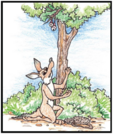
According to Goshute and Ute tradition, Coyote tales should only be told during the winter time. The tribes ask that the teacher use this lesson and story in the winter months. This lesson utilizes the Confederated Tribes of the Goshute (CTGR) tale, “Coyote Loses His Eyes” and the Ute Indian Tribe of the Uintah and Ouray Reservation (UIT) tale, “The Eye Juggler Coyote” to enhance comprehension skills and provide an introduction to comparing and contrasting plot, characters, theme and setting. The students will also be introduced to similarities and differences between the two tribes. Lastly, students will write a response summarizing using compare and contrast key words.Native peoples tell stories about Coyote and other animals to their children. Based on Coyote’s mistakes, the elders teach children about proper behavior and positive attitudes. The lessons taught help children to avoid making the same mistakes as Coyote and suffering the consequences in their own lives.
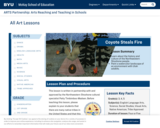
Learn about the history and culture of the Northwestern Shoshone people. Paint a watercolor landscape of an environment with Utah wildlife.
This lesson is written in partnership with and approved by the Northwestern Shoshone cultural specialist Patty Timbimboo-Madsen. Northwestern Band of Shoshone SealBefore teaching this lesson, please explain to your students that there are many native tribes in the United States and that this lesson specifically focuses on the northwestern band of the Shoshone Nation and does not represent other Native American groups. We hope that other native tribes will respect the northwestern band of the Shoshone Nation's choice to share this aspect of their culture.
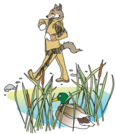
Coyote tales are part of the Paiute oral tradition used to teach proper behavior and values from an early age. These stories are only told during the winter time. The Coyote illustrates the mischievous nature in all of us. This lesson the Paiute tale, Coyote and Duck to enhance comprehension and prediction skills of students. It also helps students become familiar with cultural storytelling and its importance in Native cultures. Students will have a brief introduction to the Paiute Indian Tribe of Utah (PITU) and its location in Utah. The lesson includes a discussion about Native American regalia and explicitly addresses stereotypes.
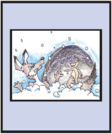
In this lesson, students are given a description of tribal sovereignty and federal recognition specific to the Confederated Tribes of the Goshute Reservation. They will also be introduced to characteristics of a trickster tale and then write a short story to activate their prior knowledge of specific words. The whole class will then read "Coyote and Mouse Make Snow," a trickster tale shared by the Confederated Tribes of the Goshute Reservation. Students will identify the characters, problems, and solutions within the story by filling out a handout. Possible extensions tie in with the Science Core.

This resource is from the Utah Division of Archives and Records Service. This primary source set contains information on infamous criminals and crimes, including Joe Hill, Butch Cassidy, John D. Lee and the Mountain Meadows Massacre, and lesser-known cases that have been largely forgotten.

This is a teacher-created resource. It is a map scavengar hunt for students to find the Hispanic influence on Utah by looking for Spanish names of places and geographical features.
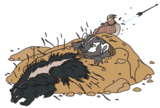
According to Paiute legend, the hawk and the coyote were not always animals as we see them now. Long ago, they were people, like you and me. The hawk was known as Kuhsawv, and the coyote was known as Soonungwuv. Coyote tales are part of the Paiute oral tradition used to teach proper behavio, natural phenomenon and values from an early age. These stories are only told during the winter time. The Coyote illustrates the mischievous nature in all of us. Students will listen to a Paiute tale and learn about folktales. They will also be introduced to the Paiute Indian Tribe of Utah, the location and how tribal members are working to preserve their language and culture. Students will also learn about how external structures and adaptations of animals help them to survive in their environment through a group activity.

Students will be able to identify the four colors important to the Navajos and understand how these colors represent different elements of Navajo culture. They will also be able to understand how values and beliefs associated with color help transmit culture from one generation to the next.
Students will understand why the Chinese and Irish immigrated to the U.S. and Utah and what they did when they got here.
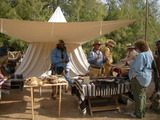
This is a lesson plan about the mountain men of Utah. This lesson can be done face-to-face or virtually.

Students will list three or more types of evidence of prehistoric cultures that encouraged archaeologists to investigate the marshes around the Great Salt Lake. Students will also explain why it is important not to disturb archaeological remains.
After learning about the Fremont people, students will make their own Fremont-Style pottery.
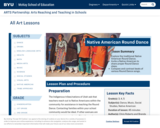
Explore the traditional Native American Round Dance. Invite a Native American to share proper Round Dance steps. Compare and contrast beats of various Round Dance songs.
The Indigenous tribes/nations of Utah ask that teachers reach out to Native Americans within the community for assistance in teaching the Round Dance. Contacting families within your school community would be ideal. If other avenues are needed, contact your district Title VI coordinator or Indian education department within your state education system.

This is a teacher-created gallery walk on the prehistoric Native American groups in Utah.